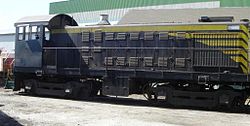| ALCO S-2 and S-4 | |||||||||||||||||||||||||||||||||||||||||||
|---|---|---|---|---|---|---|---|---|---|---|---|---|---|---|---|---|---|---|---|---|---|---|---|---|---|---|---|---|---|---|---|---|---|---|---|---|---|---|---|---|---|---|---|
 Grafton and Upton Railroad #1001, an S-4, rests in Hopedale, MA on 11 May 2008 | |||||||||||||||||||||||||||||||||||||||||||
| |||||||||||||||||||||||||||||||||||||||||||
| |||||||||||||||||||||||||||||||||||||||||||
| |||||||||||||||||||||||||||||||||||||||||||
| |||||||||||||||||||||||||||||||||||||||||||
The ALCO S-2 and S-4 are 1,000-horsepower (746 kW) diesel electric switcher locomotives produced by ALCO and Canadian licensee Montreal Locomotive Works (MLW).[1]
Powered by turbocharged, 6-cylinder ALCO 539 diesel engines, the two locomotives differed mainly in their trucks: the S-2 had ALCO "Blunt" trucks; the S-4, AAR type A switcher trucks. A total of 1,502 S-2s were built from August 1940 to June 1950; 797 S-4s were built from June 1949 to August 1957. The S-4 was first produced in Canada, with ALCO production beginning in June 1949.
The S-2 and S-4 were designed as rail yard switchers, meant to replace older, less efficient, and more demanding steam switchers.[citation needed] They were a success, with many remaining in service today.[2]
The locomotives' exterior was styled by ALCO engineer Ray Patten, who used curves in a mild application of Art Deco principles.
The S-2 and S-4 are distinguishable externally from the very similar S-1 and S-3 660 hp (492 kW) switchers in that they have a larger exhaust stack with an oblong base and a larger radiator shutter area on the nose sides. The S-1/S-3 radiator shutter area is taller than it is wide, while the S-2/S-4 radiator area is wider. The larger stack is due to turbocharging. The carbody and cab of late S-2s are nearly indistinguishable from those of S-4s. Hence, a truck swap can cause many to misidentify a unit.
- ^ "Alco "S4" Locomotives: Roster, Dimensions, Photos". American-Rails.com. Retrieved 12 May 2021.
- ^ "Preserved Diesels". thedieselshop.us. Retrieved 12 May 2021.